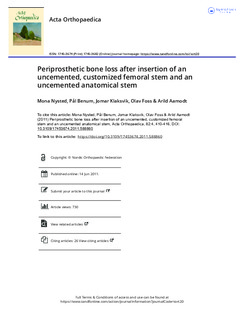| dc.contributor.author | Nysted, Mona Iren | |
| dc.contributor.author | Benum, Pål | |
| dc.contributor.author | Klaksvik, Jomar | |
| dc.contributor.author | Foss, Olav | |
| dc.contributor.author | Aamodt, Arild | |
| dc.date.accessioned | 2019-10-11T11:31:05Z | |
| dc.date.available | 2019-10-11T11:31:05Z | |
| dc.date.created | 2011-10-28T13:06:41Z | |
| dc.date.issued | 2011 | |
| dc.identifier.citation | Acta Orthopaedica. 2011, 82 (4), 410-416. | nb_NO |
| dc.identifier.issn | 1745-3674 | |
| dc.identifier.uri | http://hdl.handle.net/11250/2621605 | |
| dc.description.abstract | Background and purpose Customized femoral stems are designed to have a perfect fit and fill in the femur in order to achieve physiological load transfer and minimize stress shielding. Dual-energy X-ray absorptiometry (DXA) is regarded as an accurate method for detection of small alterations in bone mineral density (BMD) around hip prostheses. We present medium-term DXA results from a randomized study comparing a customized and an anatomical femoral stem.
Methods 100 hips were randomized to receive either the anatomical ABG-I stem or the Unique customized femoral stem, both uncemented. DXA measurements were conducted postoperatively and after 3, 6, 12, 24, 36, and 60 months, and BMD was computed for each of the 7 Gruen zones in the proximal femur.
Results Results from 87 patients were available for analysis. 78 completed the 5-year follow-up: 35 patients in the ABG group and 43 patients in the Unique group. In both groups, we found the greatest degree of bone loss in the proximal Gruen zones. In zone 1, there was 15% reduction in BMD in the ABG-I group and 14% reduction in the Unique group. In zone 7, the reduction was 28% in the ABG-I group and 27% in the Unique group. The only statistically significant difference between the groups was found in Gruen zone 4, which is distal to the tip of the stem, with 1.6% reduction in BMD in the ABG-I group and 9.7% reduction in the Unique group (p = 0.003).
Interpretation 5-year DXA results showed that because of stress-shielding, proximal bone loss could not be avoided—either for the anatomical ABG-I stem or for the customized Unique stem. | nb_NO |
| dc.language.iso | eng | nb_NO |
| dc.publisher | Taylor & Francis | nb_NO |
| dc.rights | Navngivelse-Ikkekommersiell 4.0 Internasjonal | * |
| dc.rights.uri | http://creativecommons.org/licenses/by-nc/4.0/deed.no | * |
| dc.title | Periprosthetic bone loss after insertion of an uncemented, customized femoral stem and an uncemented anatomical stem A randomized DXA study with 5-year follow-up | nb_NO |
| dc.type | Journal article | nb_NO |
| dc.type | Peer reviewed | nb_NO |
| dc.description.version | publishedVersion | nb_NO |
| dc.source.pagenumber | 410-416 | nb_NO |
| dc.source.volume | 82 | nb_NO |
| dc.source.journal | Acta Orthopaedica | nb_NO |
| dc.source.issue | 4 | nb_NO |
| dc.identifier.doi | 10.3109/17453674.2011.588860 | |
| dc.identifier.cristin | 848734 | |
| dc.description.localcode | Open Access - This article is distributed under the terms of the Creative Commons Attribution Noncommercial License which permits any noncommercial use, distribution, and reproduction in any medium, provided the source is credited. | nb_NO |
| cristin.unitcode | 1920,9,0,0 | |
| cristin.unitcode | 194,65,30,0 | |
| cristin.unitname | Klinikk for ortopedi, revmatologi og hudsykdommer | |
| cristin.unitname | Institutt for nevromedisin og bevegelsesvitenskap | |
| cristin.ispublished | true | |
| cristin.fulltext | original | |
| cristin.qualitycode | 1 | |

